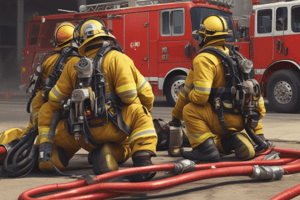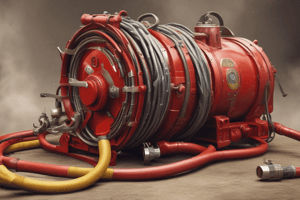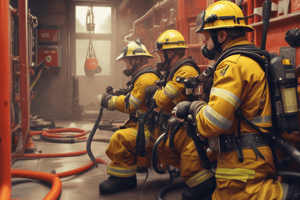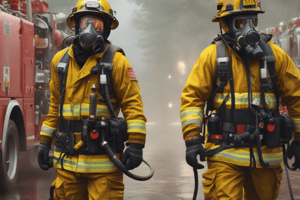Podcast
Questions and Answers
What factors should be considered when determining the proper hoseline choices for a response area?
What factors should be considered when determining the proper hoseline choices for a response area?
- Type of fire and available equipment
- Occupancy, construction, height and area as well as location (correct)
- Response time and crew experience
- Water supply and number of hydrants
What is the ideal situation of outfitting a pumper?
What is the ideal situation of outfitting a pumper?
- In high-rise commercial buildings with easy access.
- Outfit it so that it can handle the majority of fires with minimal effort and an effective attack on non routine fires (correct)
- When dealing with multiple fire types simultaneously.
- In areas with ample hydrants and low occupancy density.
What is NOT a key factor when selecting a hoseline for a fire response?
What is NOT a key factor when selecting a hoseline for a fire response?
- Type of water supply available
- Average width and height of the buildings
- Setback distance from the street
- Crew members' personal preferences (correct)
What does the consideration of occupancy have ?
What does the consideration of occupancy have ?
What is a crucial factor for hoseline selection when responding to a fire?
What is a crucial factor for hoseline selection when responding to a fire?
What aspect of a pumper's design should ideally enhance its effectiveness across varying fire situations?
What aspect of a pumper's design should ideally enhance its effectiveness across varying fire situations?
Which hoseline diameter is NOT commonly used for interior handlines?
Which hoseline diameter is NOT commonly used for interior handlines?
What should firefighters evaluate before stretching a hoseline?
What should firefighters evaluate before stretching a hoseline?
Which method is NOT mentioned for stretching a hoseline?
Which method is NOT mentioned for stretching a hoseline?
What flow rate range for interior handlines is specified?
What flow rate range for interior handlines is specified?
What should be the guiding principle when selecting a hoseline?
What should be the guiding principle when selecting a hoseline?
Which of the following is NOT a mode of attack focused on in the chapter?
Which of the following is NOT a mode of attack focused on in the chapter?
What is one advantage of using a larger hose for firefighting?
What is one advantage of using a larger hose for firefighting?
What determines the appropriate size of a hoseline for a fire?
What determines the appropriate size of a hoseline for a fire?
What is the required volume of water for a high-fire-load area?
What is the required volume of water for a high-fire-load area?
Which material has the highest heat release per pound, necessitating more water for extinguishment?
Which material has the highest heat release per pound, necessitating more water for extinguishment?
What is a common mistake firefighters make regarding hose selection?
What is a common mistake firefighters make regarding hose selection?
What contributes to the effectiveness of the initial attack on a fire?
What contributes to the effectiveness of the initial attack on a fire?
How much water is required to cool 1 pound of wrapping paper to prevent combustion?
How much water is required to cool 1 pound of wrapping paper to prevent combustion?
Which factor does NOT affect the cooling of burning materials in a fire?
Which factor does NOT affect the cooling of burning materials in a fire?
What factor directly influences the required fire flow rates in firefighting?
What factor directly influences the required fire flow rates in firefighting?
In terms of common fire incidents, which type of occupancy is most frequently encountered?
In terms of common fire incidents, which type of occupancy is most frequently encountered?
What can be inferred about occupancy in relation to firefighting strategy?
What can be inferred about occupancy in relation to firefighting strategy?
What is the first thing to consider when choosing an attack line for firefighting?
What is the first thing to consider when choosing an attack line for firefighting?
How does fire loading influence the choice of hose size?
How does fire loading influence the choice of hose size?
Why is a harder-hitting stream important in larger buildings?
Why is a harder-hitting stream important in larger buildings?
What is a key advantage of using a 2 1/2-inch hose compared to smaller hoses?
What is a key advantage of using a 2 1/2-inch hose compared to smaller hoses?
In what situation might a 2 1/2-inch hose be particularly advantageous?
In what situation might a 2 1/2-inch hose be particularly advantageous?
How many FFs for a 2 1/2 in hose?
How many FFs for a 2 1/2 in hose?
What is the recommended flow rate for most commercial occupancies to effectively combat fires?
What is the recommended flow rate for most commercial occupancies to effectively combat fires?
How many lengths of 1½-in. hose are considered the maximum for achieving 125 gpm flow?
How many lengths of 1½-in. hose are considered the maximum for achieving 125 gpm flow?
What alternative method is suggested when hose stretch exceeds practical distances?
What alternative method is suggested when hose stretch exceeds practical distances?
What is a critical factor that may influence the choice of hoseline diameter for firefighting operations?
What is a critical factor that may influence the choice of hoseline diameter for firefighting operations?
What typical friction loss per 100 ft is expected when using 2½-in. hose?
What typical friction loss per 100 ft is expected when using 2½-in. hose?
What application rate should be used to calculate the necessary water flow for a 20x50 ft commercial building?
What application rate should be used to calculate the necessary water flow for a 20x50 ft commercial building?
Which preconnect hose diameter allows up to 6 lengths (300 ft) to achieve a flow rate of 200 gpm?
Which preconnect hose diameter allows up to 6 lengths (300 ft) to achieve a flow rate of 200 gpm?
Which hose diameter is typically required if a fire in a residential occupancy has reached the flashover stage?
Which hose diameter is typically required if a fire in a residential occupancy has reached the flashover stage?
What is the recommended flow rate for a 1 3/4 inch hoseline?
What is the recommended flow rate for a 1 3/4 inch hoseline?
What is the disadvantage of walls in residential occupancy in the context of hoseline advancement?
What is the disadvantage of walls in residential occupancy in the context of hoseline advancement?
In which situation might a unit use a 1 1/2 inch hose?
In which situation might a unit use a 1 1/2 inch hose?
What is the flow rate of a navy fog nozzle
What is the flow rate of a navy fog nozzle
Note that ___ gpm/sq ft is the recommended flow rate for most commercial occupancies given the predominance of plastics in the current fire environment
Note that ___ gpm/sq ft is the recommended flow rate for most commercial occupancies given the predominance of plastics in the current fire environment
Putting the proper __ hoseline at the required ____ in the least possible ___ with the most ____ use of personnel is the ___ of the engine company. Pg 61 ch 4
Putting the proper __ hoseline at the required ____ in the least possible ___ with the most ____ use of personnel is the ___ of the engine company. Pg 61 ch 4
This ch covers the following 3 interrelated topics directly putting water on fire: proper ___ and ___, ___ and ___ stretching the line, making sure it’s stretched to the proper ____
This ch covers the following 3 interrelated topics directly putting water on fire: proper ___ and ___, ___ and ___ stretching the line, making sure it’s stretched to the proper ____
Flow rates of __- ___ gpm are available for interior handlines
Flow rates of __- ___ gpm are available for interior handlines
Such factors as the buildings ____, construction, ___ and ___ as well as the ___ and ___ of the fire have a direct bearing on hoseline selection and placement. The method of stretch will be determined by such factors as the presence of ____, open stairwells, and usable
Such factors as the buildings ____, construction, ___ and ___ as well as the ___ and ___ of the fire have a direct bearing on hoseline selection and placement. The method of stretch will be determined by such factors as the presence of ____, open stairwells, and usable
Formulas have been devised based on the ___ of the area and ___ of the fire load. They vary from __ gpm for every ___ sqft in low fire load settings to __ gpm for high fire load areas
Formulas have been devised based on the ___ of the area and ___ of the fire load. They vary from __ gpm for every ___ sqft in low fire load settings to __ gpm for high fire load areas
Water absorbs about ____ btu per gal when raised from __ degrees to completely vaporized
Water absorbs about ____ btu per gal when raised from __ degrees to completely vaporized
The consideration of ____ will have a direct bearing in the required fire ___rates, therefore the ____ of the attack line
The consideration of ____ will have a direct bearing in the required fire ___rates, therefore the ____ of the attack line
Residences of three characteristics that play an important role when selecting hoselines: 1 need for ___, 2 relatively ___ fire loading 3 the presence of ____ walls and ____ between rooms which has two effects
Residences of three characteristics that play an important role when selecting hoselines: 1 need for ___, 2 relatively ___ fire loading 3 the presence of ____ walls and ____ between rooms which has two effects
In the US roughly __ percent of fire deaths occur in residential buildings pg __
In the US roughly __ percent of fire deaths occur in residential buildings pg __
As a practical matter if a fire in a residential occupancy has reached flashover stage a hoseline of Atleast __ diameter is required
As a practical matter if a fire in a residential occupancy has reached flashover stage a hoseline of Atleast __ diameter is required
A unit that responds to homes built on slabs will probably be able to use __ in hose to good advantage, while units that face larger homes and those with ___ and ____ may require __ or __ in hose
A unit that responds to homes built on slabs will probably be able to use __ in hose to good advantage, while units that face larger homes and those with ___ and ____ may require __ or __ in hose
1 3/4 hose provides sufficient flow to knockdown ___ or ___ rooms to fire rapidly yet it also allows the necessary speed in stretching and the flexibility during advancement that is required in multi story apartment buildings
1 3/4 hose provides sufficient flow to knockdown ___ or ___ rooms to fire rapidly yet it also allows the necessary speed in stretching and the flexibility during advancement that is required in multi story apartment buildings
Whenever any sizable body of fire is present or if the true volume of fire cannot be readily determined in most ___ and ____ properties this dictates that a ___ in line should be stretched
Whenever any sizable body of fire is present or if the true volume of fire cannot be readily determined in most ___ and ____ properties this dictates that a ___ in line should be stretched
___ is a definite advantage of larger streams. When surveying your response area look for buildings about __ ft in width or depth
___ is a definite advantage of larger streams. When surveying your response area look for buildings about __ ft in width or depth
A 2 1/2 in line flowing ___ gpm through a ___ in tip can be handled by __ and moved by ___.
A 2 1/2 in line flowing ___ gpm through a ___ in tip can be handled by __ and moved by ___.
A common commercial building is the strip mall or taxpayer. The average store in such a building measures ____ ft. Ch 4 pg 66
A common commercial building is the strip mall or taxpayer. The average store in such a building measures ____ ft. Ch 4 pg 66
Any heavily involved commercial building larger than about ___ ft will need more water than a single __ in line. For example O.35 gpm/sqft works out to ___ gpm. Note that .35 is the recommended flow rate for commercial occupancies due to plastics
Any heavily involved commercial building larger than about ___ ft will need more water than a single __ in line. For example O.35 gpm/sqft works out to ___ gpm. Note that .35 is the recommended flow rate for commercial occupancies due to plastics
Flashcards
Hoseline Selection
Hoseline Selection
Choosing the right size and type of hose for effective fire control.
Initial Fire Assessment
Initial Fire Assessment
Observing smoke and conditions to choose appropriate lines.
Flow Rate (gpm)
Flow Rate (gpm)
Amount of water delivered per minute, differing based on fire size.
Building Characteristics
Building Characteristics
Signup and view all the flashcards
Large Buildings
Large Buildings
Signup and view all the flashcards
Pre-Connects
Pre-Connects
Signup and view all the flashcards
Hose Diameter
Hose Diameter
Signup and view all the flashcards
Water Discharge Requirements
Water Discharge Requirements
Signup and view all the flashcards
Fire Load
Fire Load
Signup and view all the flashcards
Fuel Characteristics
Fuel Characteristics
Signup and view all the flashcards
Hose Sizes
Hose Sizes
Signup and view all the flashcards
Residential Fires
Residential Fires
Signup and view all the flashcards
Dividing Walls
Dividing Walls
Signup and view all the flashcards
Large Fires
Large Fires
Signup and view all the flashcards
Strip Malls
Strip Malls
Signup and view all the flashcards
Command and Resource Management
Command and Resource Management
Signup and view all the flashcards
Hose Stretches
Hose Stretches
Signup and view all the flashcards
Officer Protocol
Officer Protocol
Signup and view all the flashcards
Evolving Conditions
Evolving Conditions
Signup and view all the flashcards
Fire Dynamics
Fire Dynamics
Signup and view all the flashcards
Study Notes
Hoseline Selection and Placement
- Approach fire scenes noting visible smoke and assess initial conditions before stretching hoselines.
- Priority is to quickly and efficiently deploy the proper size and type of hoseline for effective fire control.
- Flow rates for interior handlines range from 12 to 325 gpm, depending on the fire's size and materials involved.
- Evaluating occupancy, construction, height, and location of fire is essential for correct hoseline selection.
Factors Influencing Hoseline Stretching
- Large buildings generally require larger hoses due to potential fire intensity and reach.
- Common practice includes assessing need for larger lines; inappropriate pre-connects can lead to unfavorable outcomes.
- Optimal hose diameter impacted by fire loading: smaller lines for light loads, larger for heavy fire involvement.
Water Discharge Requirements
- Successful fire extinguishment relies on sufficient water volume and effective reach to target fire directly.
- Discharge criteria include covering area with appropriate gallons per minute (gpm) based on fire type and location.
Hazard Assessment and Firefighting Strategy
- Use formulas to determine required flow rates, depending on the fuel load and area size (15 gpm for low-fire load to 60 gpm for high).
- Familiarize with the characteristics and heat output of fuels; e.g., styrene foam requires more water than wrapping paper for effective cooling.
Size of Hoseline Recommendations
- Recommended hose sizes vary from 1/2-inch for small, confined fires to 2 1/2-inch for larger commercial fires.
- Practical flows identified include: 1/2-inch hose (125 gpm), 1 3/4-inch hose (180 gpm), and 2-inch hose (225 gpm).
Fire Dynamics and Challenges
- Residential fires often need maneuverability and speed; smaller hoses can suffice unless flashover occurs.
- Incorporating dividing walls can hinder fire spread but may obstruct hoseline deployment.
Considerations for Larger Fires
- Large fires necessitate powerful 2 1/2-inch hoses; smaller hoses produce inadequate flow for extensive operations.
- Strip malls: 2 1/2-inch hoses cover depth and height, optimizing fire control.
Effective Command and Resource Management
- Preconnected lines should accommodate typical building sizes in the area; limitations on excessively long small-diameter hoses prevent inefficiency.
- Maintain hose stretches under manageable lengths to reduce friction loss and maintain required flow rates.
Officer's Protocol and Strategy Execution
- Quickly assess building types to determine appropriate hoseline choices, focusing on reach and volume needs.
- Ensure fire suppression strategies adapt based on evolving conditions and observable hazards on-site during initial response.
Studying That Suits You
Use AI to generate personalized quizzes and flashcards to suit your learning preferences.




